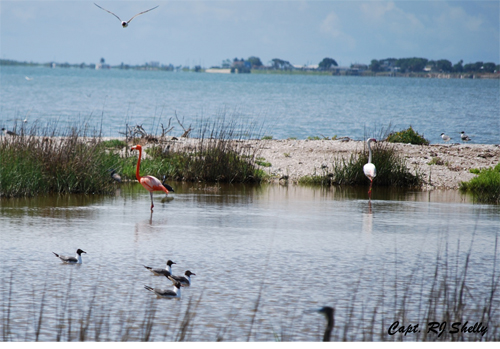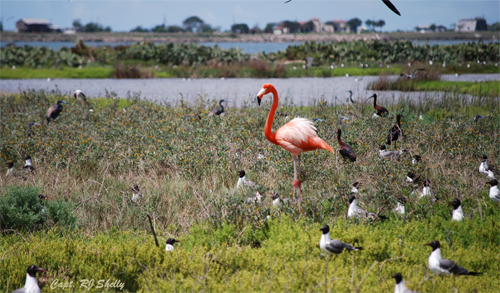There is something special about big pink birds. Everybody loves them and admires their beauty. Watching them flying with a long stretched-out neck, long trailing legs and an impossibly pink body against a blue sky is a sight not even the most callous person can ignore. A flock of them feeding together in our local marshes and wetlands can make a bird watcher out of just about anybody. Despite the fact that those big pink birds in our area are sometimes called (Texas) flamingos by folks not familiar with the correct bird names they are, however, Roseate Spoonbills unless they reside permanently on somebody’s front lawn or deck and haven’t moved in years. Flamingos just don’t live in Texas, right!? Or do they?
Have a close look at the photos local fishing guide RJ Shelly recently took from a Lavaca Bay spoil island. Those hooked beaks do certainly not look like a spoonbill. That peculiar hook is indeed typical for a flamingo and the two on this photo, one much brighter than the other, have a history that revealed itself bit by bit with lots of patience and some sleuthing detective work. The story starts in 2005 …
On 14 October 2005 a flamingo was spotted and photographed in Shoalwater Bay, Calhoun County. The photo showed a wide yellow band on the right and a narrow blue band on the left leg but was not clear and close enough to read the band inscriptions. Later it moved to the shallow bays near Goose Island State Park and Bludworth Island. Its pale plumage pointed towards a young bird that had not yet molted into the bright orange pink adult plumage. It took a while to get good enough looks at the yellow band but when the code could finally be read, its letters HDNT lead to the bird bander in Mexico. Dr. Rodrigo Migoya and his organization banded a 3 kilogram (about 7 pounds) heavy youngster at the Rio Lagartos Biosphere Reserve on the Yucatan Peninsula on August 14th, 2005. And so the first piece of the puzzle was solved!
HDNT disappeared from the reefs around Goose Island around the end of April 2006. On 25 July of 2006 another flamingo was spotted in the marshes of Bayside. It did not have a blue band and was much more colorful but after much work with a spotting scope and long telephoto lenses the yellow band on the left leg showed the familiar HDNT. Our youngster was growing up, getting more colorful and had lost the blue band somehow. It moved about a bit and disappeared from public view for a while. But on 17 November 2006 another thrilling discovery was made by a TPWD biologist on Whitmire Lake near Indianola while flying waterfowl surveys.
Not one, but two flamingos were spotted from the plane. The fact that one was bright pink and the other very pale suggested an adult with a juvenile. A couple of weeks later closer looks from the ground showed that both flamingos were banded. The bright one turned out to be our by now familiar HDNT from the Yucatan while the paler one was not a juvenile American Flamingo at all but a Greater Flamingo from the Old World. The 2-toned bill and pale plumage helped in identifying it. The numbers on its band were initially only read partially and upside down to boot so it took a while to figure out where it came from but finally this puzzle piece fell into place, too. The Sedgwick Zoo in Wichita, Kansas was missing this bird.
Now, what are the chances that a lost youngster flamingo from the Yucatan and an escaped Old World flamingo from Wichita, Kansas would eventually find each other in Calhoun County and stick together for company? Lottery tickets and lightning strikes come to mind. But the story continues …..
In late January of 2007 the mismatched pair of flamingos left the Whitmire Lake and moved about 20 miles WSW to the Lower Guadalupe Delta where they were photographed on a private ranch. They made it through cold spells and heat waves, showed up in wetlands north of the Port Lavaca Causeway and near Zimmerman Rd. close to Magnolia Beach. Sightings were reported from Baffin Bay and places along the upper Laguna Madre and from the upper Texas Coast all the way to wetlands in Louisiana.
But now the two are back to where they were first spotted together … Calhoun County. They know our county well and I hope they will find plenty of food and a safe heaven for many more years together.
Please be aware that the spoil islands in Lavaca Bay are currently full of nesting species and off limits to visitors. Any human access or even close approach by boat can and will scare breeding birds off their nests, which endangers the survival of young birds and eggs. Be considerate and enjoy them from a distance or from these great photos.


